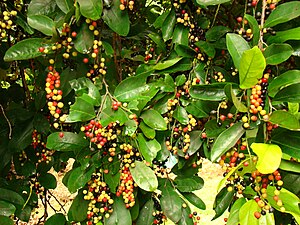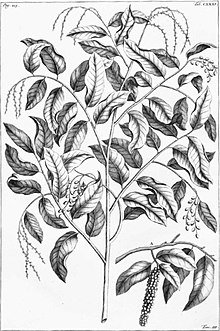Antidesma bunius
| Antidesma bunius | ||||||||||||
|---|---|---|---|---|---|---|---|---|---|---|---|---|

Leaves and fruits of Antidesma bunius |
||||||||||||
| Systematics | ||||||||||||
|
||||||||||||
| Scientific name | ||||||||||||
| Antidesma bunius | ||||||||||||
| ( L. ) Explos. |
Antidesma bunius , as Buni , Bignay , Bignai or salamander tree called, is a tree from the family of Phyllanthaceae . The species is oftenassigned tothe milkweed family(Euphorbiaceae). The natural range is in India , Sri Lanka , Myanmar , Thailand and Malaysia . However, the species is also grown in other areas and can also grow wild there. The fruits are both eaten raw and processed.
description
Vegetative characteristics
Antidesma bunius is an evergreen , dioecious diocese and richly branched, up to 10 meters, rarely up to 30 meters high tree with a dense, spreading crown. It rarely grows shrub-like. The bark is yellowish brown, smooth or cracked. Young twigs are hairy brown, glabrous or rusty red. Older trees can have buttress roots .
The leaves are alternate and arranged in two rows. They are simple and have a 3 to 10, rarely up to 17 millimeter long, glabrous or reddish brown fluffy stalk. The coarse leathery leaf blade is usually 10 to 23 centimeters long, rarely only 5 or up to 32 centimeters long and rarely from 2, but mostly 3 to 10 centimeters wide, oblong, elliptical or obovate, pointed with a pointed or rounded base and entire margins. The upper side of the leaf is dark green, shiny and glabrous, the underside is a bit lighter, glabrous, slightly hairy on the veins or reddish downy hairy. The midrib emerges strongly on the underside of the leaf. Seldom five, usually seven to 11 pairs of nerves are formed. The third order veins are arranged in a network. The stipules are 4 to 6 millimeters long and 1.5 to 2 millimeters wide, linear and fall off early.
Generative characteristics
The flowers are numerous in terminal and axillary, up to 18 centimeters long racemes . The yellowish to reddish or greenish single flowers are inconspicuous and fragrant. Male flowers are sessile and have a broad, bell-shaped, 1 to 1.5 millimeter wide, three to four-lobed, rarely five-lobed calyx . The three or four, rarely five stamens are 2 to 3 millimeters long. The partially existing ovary is cylindrical to club-shaped. The female flowers grow on stems 0.5 to 1, rarely up to 2 millimeters long, which extend to 2 to 4, rarely up to 9 millimeters, when the fruit is ripe. The chalice is tripod. The ovary is bald or hairy and has three to four, rarely up to six scars .
The fruits are round or egg-shaped drupes about 1 centimeter in size, arranged in 20 centimeters long, hanging clusters. The individual fruits grow on stems that are 5 millimeters long. They are initially green and then turn yellowish to red to black-purple. Depending on the fruit cluster, there are fruits of different degrees of ripeness and therefore different colors. The skin is thin, smooth and shiny. The pulp is about 3 millimeters thick, juicy and glassy. The taste is refreshing, sour or sweet and sour, not very aromatic and sometimes bitter. (The taste sensation "bitter" depends on the genetic disposition of the test person . This disposition is reciprocal to the ability of the bitter sensation of phenylthiocarbamide (PTC).) To have ripe fruits a red, strongly coloring juice. The hard and light brown stone cores are 9 millimeters long, 7 millimeters wide and 4 millimeters high, flattened ovoid, pointed, keeled all around with a warty surface. The species blooms from March to May, the fruits ripen from June to November.
The number of chromosomes is x = 13.
distribution
The original range of Antidesma bunius is in India, Sri Lanka, Myanmar, Thailand and Malaysia. There the species grows in forests at heights of 200 to 1800 meters in areas with high levels of precipitation. The species is often cultivated in China, Indochina , Indonesia, the Philippines and on Pacific islands such as Hawaii and Tahiti , where it is also occasionally wild. The trees are seldom planted in Florida , Central America and northern Australia.
Systematics and research history
The Vorlinnae name Bunius sativa or arbor Salamandra comes from the German-Dutch naturalist Georg Eberhard Rumpf , nicknamed Pliny Indicus , who lived on the Moluccas for 45 years. He had described two types: Bunius sativa , which occurs on Java and Celebes, and Bunius agrestis or Wilder Bunius, which occurs on the Moluccas .
Antidesma bunius is a species of the genus Antidesma in the family Phyllanthaceae . There it is assigned to the subfamily Antidesmatoideae, Tribus Antidesmateae, Untertribus Antidesmatinae. It is often assigned to the family of the milkweed family (Euphorbiaceae), subfamily Stilaginaceae. The species was by Carl Linnaeus in 1767 in his work Mantissa Plantarum as Stilago bunius ( Basionym ) first described . Kurt Sprengel assigned them to the genus Antidesma in 1824 .
There are two varieties :
- Antidesma bunius var. Bunius with or without whitish hairs and bald or hairy leaf underside only on the veins. Ovaries and fruits are bare.
- Antidesma bunius var. Pubescens Petra Hoffmann with generally reddish hair and also completely hairy underside of the leaf. Ovaries and fruits are finely hairy. Distribution area is the Chinese province of Yunnan and Thailand.
use
The sour and rich in vitamin C fruits are eaten ripe as fruit. They are steamed as an ingredient in fish and other dishes or processed with sugar to make jelly, jams, syrup or fruit juices. In Southeast Asia, the sour-tasting leaves are eaten raw in salads or cooked with rice. Due to the impressive fruit stands, the species is also a popular ornamental wood. Fibers for making ropes and cords can be extracted from the bark.
The plants are propagated by seeds or by cuttings and sinkers . About 5 to 8 months after flowering, the fruit clusters are harvested when most of the fruits have turned red.
literature
- Bernd Nowak, Bettina Schulz: Pocket dictionary of tropical crops and their fruits . Quelle & Meyer, Wiebelsheim 2009, ISBN 978-3-494-01455-5 , p. 59-61 .
- Wu Zheng-yi, Peter H. Raven, Deyuan Hong (Eds.): Flora of China . Volume 11: Oxalidaceae through Aceraceae . Science Press / Missouri Botanical Garden Press, Beijing / St. Louis 2008, ISBN 978-1-930723-73-3 , pp. 211 (English).
- P. Hoffmann: Antidesma in Malesia and Thailand. Royal Botanic Gardens Kew, 2005, ISBN 1-8424-6045-5 , online at Nationaal Herbarium Nederland.
Web links
- Antidesma bunius. In: The Plant List. Retrieved March 19, 2012 (English).
- Antidesma bunius at Useful Tropical Plants.
- Antidesma bunius at Growables.
Individual evidence
- ^ A b c German names according to Nowak, Schulz: Pocket dictionary of tropical useful plants and their fruits. P. 59.
- ↑ a b Nowak, Schulz: Pocket dictionary of tropical useful plants and their fruits, p. 59.
- ↑ a b c d e f g Bingtao Li, Petra Hoffmann: Antidesma bunius in Flora of China , Volume 11, p. 211.
- ↑ Nature 265 (5594): 536-537 A minority perceives the fruits as bitter and inedible, the majority has the perception “sweet”.
- ↑ a b c d Nowak, Schulz: Pocket dictionary of tropical useful plants and their fruits. P. 60.
- ↑ Georg Eberhard Rumpf . Herbarium Amboinense. Bunius , Liber V, Cap. 49, 1743
- ↑ Stilago bunius. In: Germplasm Resources Information Network (GRIN). United States Department of Agriculture, accessed March 19, 2012 .
- ^ Antidesma bunius. In: Germplasm Resources Information Network (GRIN). United States Department of Agriculture, accessed March 19, 2012 .
- ^ Bingtao Li, Petra Hoffmann: Antidesma bunius var. Pubescens in Flora of China , Volume 11, p. 211.

